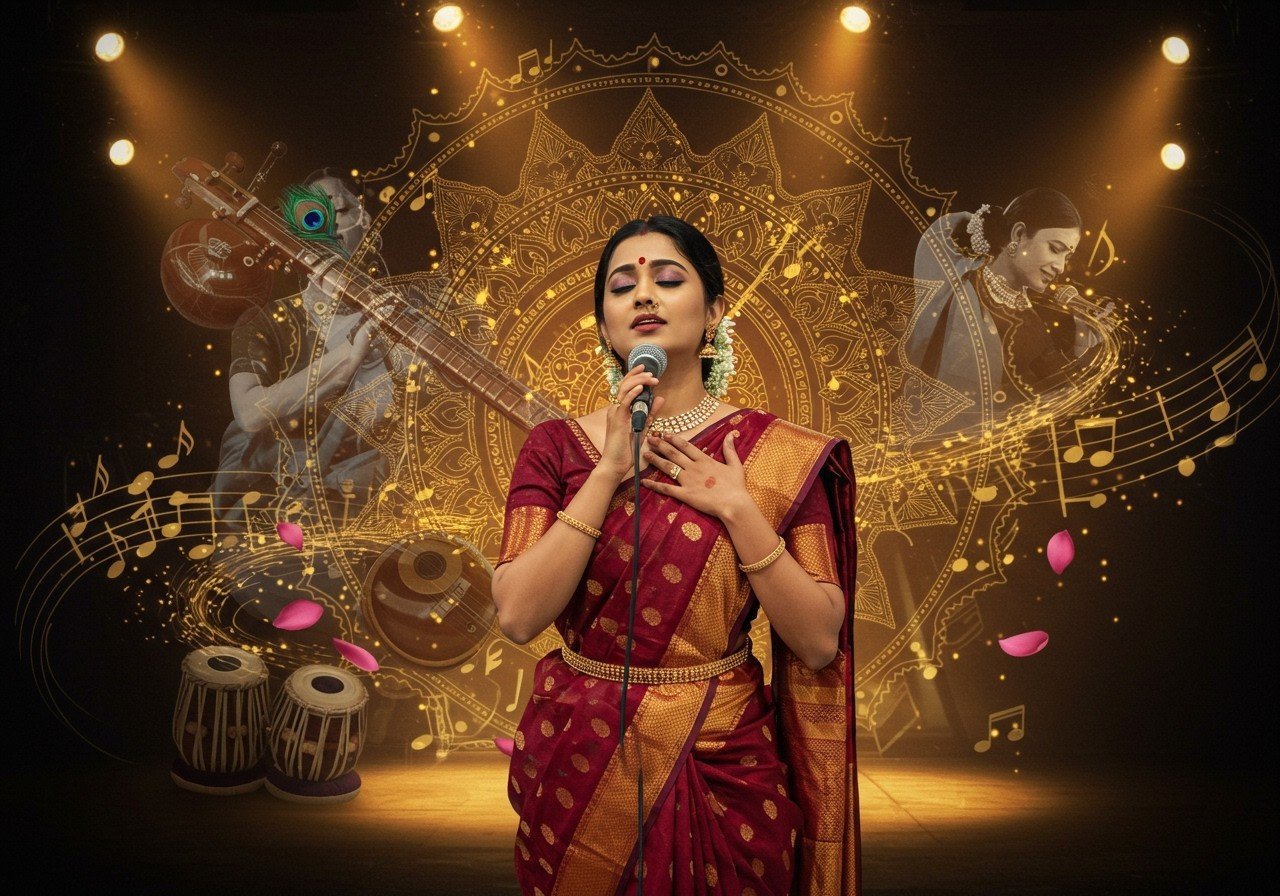
Indian classical music, a revered tradition, has profoundly shaped India’s cultural and spiritual landscape. Vocal music holds a special place, offering a rich tapestry of melodic heritage. This article delves into the intricacies of Indian classical vocals, exploring their origins, diverse styles, and the mastery required for performance. We’ll examine both Hindustani and Carnatic traditions, providing insights into their unique characteristics and contributions to India’s musical legacy.
Origins and Historical Evolution
Indian classical vocal music boasts ancient roots, traceable to scriptures like the Vedas and Upanishads, highlighting music’s significance in religious ceremonies. Historical figures like Tansen during the Mughal era (around the 16th century) and Purandara Dasa (1484-1564) in South Indian music significantly contributed to its development. The Bhakti and Sufi movements also influenced devotional singing styles. Traditional Gurukuls played a crucial role in preserving and transmitting vocal music knowledge across generations. However, colonialism and modernity brought both challenges and transformations to the preservation of these classical vocals, impacting how they are practiced and perceived today. Numerous books and manuscripts meticulously document this fascinating history of Indian vocal music.
Hindustani Vocal Music: North India’s Tradition
Hindustani classical vocals originate from North India. Understanding key terms like ‘Raag’ (melodic framework), ‘Taal’ (rhythmic cycle), and ‘Bandish’ (composition) is essential. Hindustani vocals encompass various styles:
- Dhrupad: The oldest style, known for its serious and meditative tone, often focusing on philosophical and spiritual themes.
- Khayal: A more flexible style, allowing for improvisation and elaborate melodic explorations, making it popular among performers.
- Thumri: A lighter, semi-classical form, focused on emotional expression and storytelling, often depicting romantic themes.
Prominent vocalists like Pandit Bhimsen Joshi, Ustad Rashid Khan, Kishori Amonkar, Pandit Jasraj, Rajan and Sajan Mishra, and Veena Sahasrabud have made invaluable contributions. Improvisation is a cornerstone of Hindustani music, allowing artists to showcase their creativity within the traditional framework. Accompanying instruments like the harmonium, tabla, and tanpura enrich vocal performances, creating a captivating sonic experience. Cultural festivals and concert platforms play a vital role in disseminating and appreciating Hindustani vocal music.
Carnatic Vocal Music: South India’s Melodic Tapestry
Carnatic vocal music hails from South India. Central to this tradition are concepts like ‘Raga’, ‘Tala’, and ‘Kriti’ (composition). A typical Carnatic concert follows a structured format:
- Alapana: An improvisational introduction of the raga, gradually unfolding its melodic contours and setting the mood.
- Niraval: Improvisation within a specific section of the composition, exploring melodic and rhythmic variations around a chosen phrase.
- Kalpana Swaras: Improvised rhythmic patterns using solfege syllables (swaras), demonstrating the vocalist’s mastery over the raga and tala.
Legendary vocalists like M.S. Subbulakshmi, Balamuralikrishna, and Aruna Sairam have significantly enriched the Carnatic tradition. Compositions by the Trinity of Carnatic music—Tyagaraja, Muthuswami Dikshitar, and Syama Sastri—form the core repertoire.
Techniques and Mastery: A Lifelong Pursuit
Mastering Indian classical vocals demands rigorous training, dedication, and often begins under a guru’s guidance from a young age. ‘Voice culture’ is paramount, involving exercises to develop vocal strength, flexibility, and clarity. Understanding and perfecting ‘Swaras’ (notes) and ‘Shruti’ (microtones) is crucial. ‘Sadhana’ (dedicated practice) is essential, involving hours of daily riyaz to refine techniques and cultivate a deep musical understanding. Breath control and ‘Pranayama’ are vital for stamina and controlled performances. Emotional expression (‘Bhava’) is key to connecting with the audience. Each ‘Gharana’ (school) possesses unique styles and techniques passed down through generations. Modern technology, including online tutorials and apps, supplements traditional learning, making it more accessible.
Cultural Impact and Contemporary Relevance
Indian classical vocal music has a profound cultural impact and remains relevant today. Bollywood music often incorporates classical elements, adding depth to popular songs. It influences Indian dance forms like Bharatanatyam and Kathak. A resurgence of interest among younger generations is evident, fueled by online platforms and social media. Music academies and institutions actively promote classical traditions. Collaborations between Indian and international artists showcase the global appeal of Indian music. Classical music festivals raise awareness and appreciation, bringing together diverse artists and audiences.
Enhance Your Classical Music Experience with Poojn.in
Poojn.in, India’s leading cultural goods store, offers a curated selection of products for classical music enthusiasts. Explore our range of traditional instruments, puja items for music ceremonies, and more. Whether you are a seasoned musician or just beginning your journey, poojn.in has something for everyone.
- Tulsi Kanthi Mala: Embrace the tradition with a genuine Tulsi Kanthi Mala, perfect for daily wear or special occasions.
- Brass Radha Krishna Murti: Adorn your altar with a beautifully crafted brass Radha Krishna Murti, symbolizing divine love and devotion.
Conclusion
Indian classical vocal music is a captivating blend of tradition, technique, and emotion. It demands dedication, but the rewards are immeasurable. Aspiring vocalists should immerse themselves in the rich heritage, learning from gurus and embracing modern tools. Its cultural impact is immense, influencing diverse art forms. This melodic heritage thrives, inspiring new generations and bridging cultures. Embrace this art form, and let its profound beauty and wisdom enrich your life.
FAQs on Vocal Music of India
What distinguishes Hindustani and Carnatic music? Hindustani music, from North India, emphasizes improvisation and features ragas like Darbari and Yaman. Carnatic music, from South India, follows a more structured format with distinct ragas like Shankarabharanam and Kalyani.
How can I start learning Indian classical vocals? Begin by finding a qualified guru who can provide personalized guidance. Regular practice (riyaz) and understanding the basics of swaras (notes), talas (rhythms), and ragas are essential.
What are some renowned Indian classical vocalists? Notable figures include Bhimsen Joshi, Pandit Jasraj, Kishori Amonkar, Rashid Khan, Rajan and Sajan Mishra, and Veena Sahasrabud in Hindustani music, and M.S. Subbulakshmi, Balamuralikrishna, and Aruna Sairam in Carnatic music.


